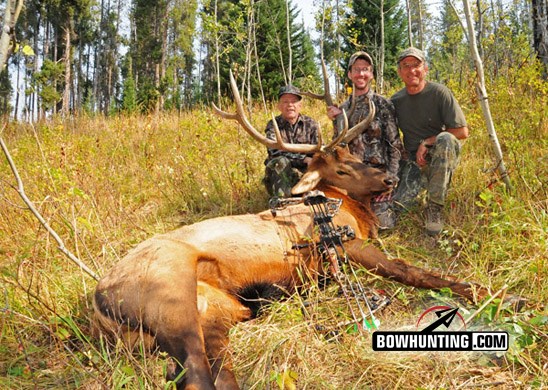It’s early morning in September 2012, nearly 7,000 feet up in the Idaho wilderness. Three intrepid hunters are stealthily tracking a bugling bull elk when they lose track of the beast. The morning is eerily silent, the elk not having called for nearly half an hour. The hunters pause, listening intently for any sign of the creature. Follow along on this exciting bow hunt as Bowhunting.com’s Patrick Durkin describes what happens next:
I nodded toward a small lodge-pole pine 40 yards ahead where the forest faded into an aspen meadow. Turning to White I whispered over my shoulder: “Sneak up to that pine and get ready. I’ll drop back and give a cow call.” But before we could separate, White hissed, “There he is.” Sheesh! So much for that plan. The big bull was crossing the meadow, its broad chest cleaving young aspens and tall grass as it headed straight at us. Then it stopped about 50 yards away and stared. We held our breath, slumped like stumps, hoping our camouflage clothing and face nets blended with the background. Just when we thought the bull would whirl and flee, it resumed walking. When it was 30 yards away on a parallel course, I noticed White lifting his bow to draw. “Wait!” I cautioned quietly, fearing the bull’s peripheral vision would spot the motion. The bull never slowed. It passed us at 25 yards, giving White a slightly quartering-away shot. “Draw,” I whispered, hoping I sounded calm and helpful. Remember, this was only the third day of White’s first elk hunt. In fact, he hadn’t yet arrowed a deer since taking up bowhunting a few years ago. The last thing he needed was some old guy – well-meaning or not — increasing the pressure. As excited as I felt, I couldn’t imagine what he was feeling.
Photos: Bowhunting.com



















![The Best Deer Camp Chili [VIDEO] Deer Chili Ingredients, Tomatoes, Chili Spices](/wp-content/uploads/2015/10/Deer-Chili-Deer-Camp-Recipe-218x150.jpg)
![How to Call Elk Early in the Season [VIDEO]](/wp-content/uploads/2016/08/byers003-218x150.jpg)





![Idiots Disturb Hunter: How Would You Have Handled It? [VIDEO]](/wp-content/uploads/2015/10/DSC00110-e1474487693878-100x70.jpg)
![Albino Buck Shocked to Shed His Antlers [VIDEO]](/wp-content/uploads/2015/10/AlbinoDeer-100x70.jpg)